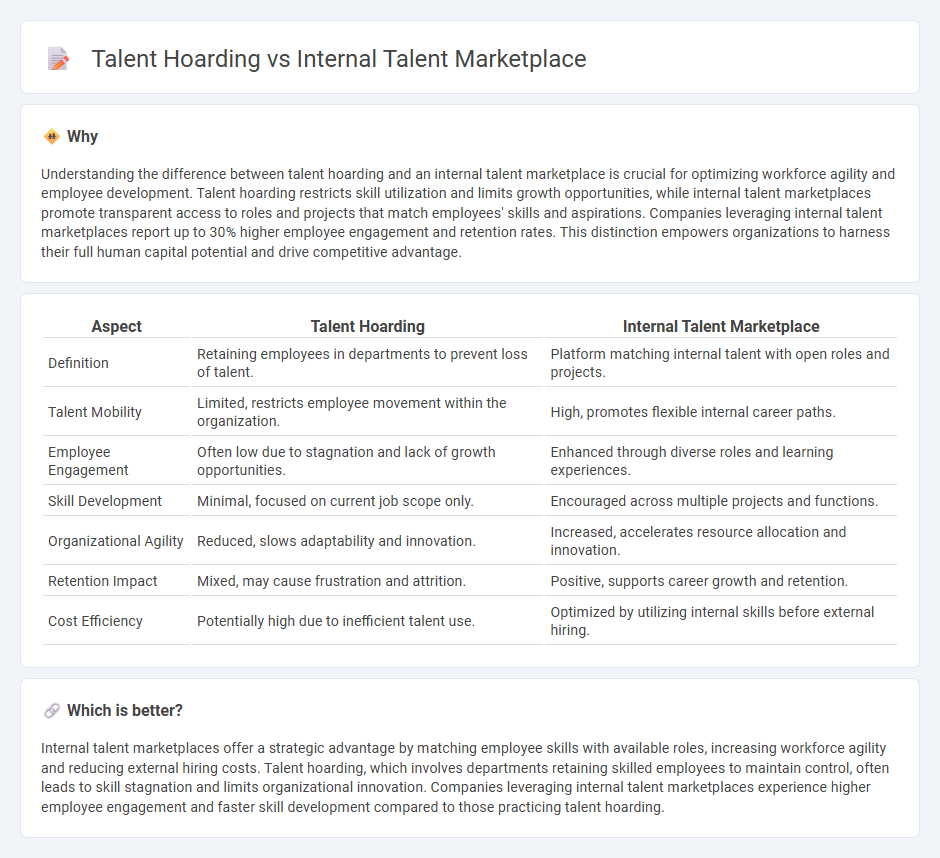
Talent hoarding impedes organizational growth by restricting access to skilled employees within departments, limiting collaboration and innovation. In contrast, an internal talent marketplace leverages existing workforce capabilities by facilitating transparent job postings and skill-based matching, promoting career development and operational agility. Discover how shifting to an internal talent marketplace can transform workforce management and enhance business performance.
Why it is important
Understanding the difference between talent hoarding and an internal talent marketplace is crucial for optimizing workforce agility and employee development. Talent hoarding restricts skill utilization and limits growth opportunities, while internal talent marketplaces promote transparent access to roles and projects that match employees' skills and aspirations. Companies leveraging internal talent marketplaces report up to 30% higher employee engagement and retention rates. This distinction empowers organizations to harness their full human capital potential and drive competitive advantage.
Comparison Table
| Aspect | Talent Hoarding | Internal Talent Marketplace |
|---|---|---|
| Definition | Retaining employees in departments to prevent loss of talent. | Platform matching internal talent with open roles and projects. |
| Talent Mobility | Limited, restricts employee movement within the organization. | High, promotes flexible internal career paths. |
| Employee Engagement | Often low due to stagnation and lack of growth opportunities. | Enhanced through diverse roles and learning experiences. |
| Skill Development | Minimal, focused on current job scope only. | Encouraged across multiple projects and functions. |
| Organizational Agility | Reduced, slows adaptability and innovation. | Increased, accelerates resource allocation and innovation. |
| Retention Impact | Mixed, may cause frustration and attrition. | Positive, supports career growth and retention. |
| Cost Efficiency | Potentially high due to inefficient talent use. | Optimized by utilizing internal skills before external hiring. |
Which is better?
Internal talent marketplaces offer a strategic advantage by matching employee skills with available roles, increasing workforce agility and reducing external hiring costs. Talent hoarding, which involves departments retaining skilled employees to maintain control, often leads to skill stagnation and limits organizational innovation. Companies leveraging internal talent marketplaces experience higher employee engagement and faster skill development compared to those practicing talent hoarding.
Connection
Talent hoarding, where managers retain high-performing employees to secure team success, limits workforce agility and hampers organizational growth. Internal talent marketplaces counteract this by facilitating transparent job matching within a company, enabling employees to access new roles and projects aligned with their skills. This dynamic reduces talent hoarding tendencies, optimizes resource allocation, and fosters a more flexible and innovative workforce.
Key Terms
Talent Mobility
An internal talent marketplace enhances talent mobility by matching employees with opportunities aligned to their skills, while talent hoarding restricts workforce agility by limiting internal movement and growth. Companies fostering talent mobility see improved employee engagement and optimized resource allocation, driving innovation and retention. Explore how adopting internal talent marketplaces can transform your organization's talent strategy.
Skills Matching
Internal talent marketplaces leverage advanced skills matching algorithms to connect employees with projects that align with their competencies, facilitating career growth and organizational agility. Talent hoarding restricts access to opportunities, causing skill underutilization and hindering workforce optimization. Explore how embracing internal talent marketplaces can transform your talent management strategy.
Workforce Agility
Internal talent marketplaces foster workforce agility by enabling seamless skills matching and project-based talent deployment across departments, which contrasts with talent hoarding where employees are retained within siloed units limiting organizational flexibility. Companies leveraging internal talent marketplaces report faster project delivery, increased employee engagement, and enhanced skill development due to transparent career mobility. Explore how implementing internal talent marketplaces can transform your organization's workforce agility and competitive advantage.
Source and External Links
The Talent Marketplace: A Comprehensive Guide - Avature - Internal talent marketplaces are dynamic platforms that integrate talent management activities across the employee lifecycle, enabling seamless internal mobility and personalized employee development within a unified ecosystem.
Best Internal Talent Marketplaces Reviews 2025 - Gartner - These marketplaces use AI-enabled skills management to connect employees with internal opportunities like projects, gigs, and full-time roles based on skills and aspirations, thereby promoting talent agility and equitable access to growth.
The Talent Marketplace: How It Works & Why You Need It - Gloat - Talent marketplaces leverage AI to match employees with internal jobs and development opportunities, optimizing talent usage while reducing hiring costs and enhancing internal mobility.
 dowidth.com
dowidth.com